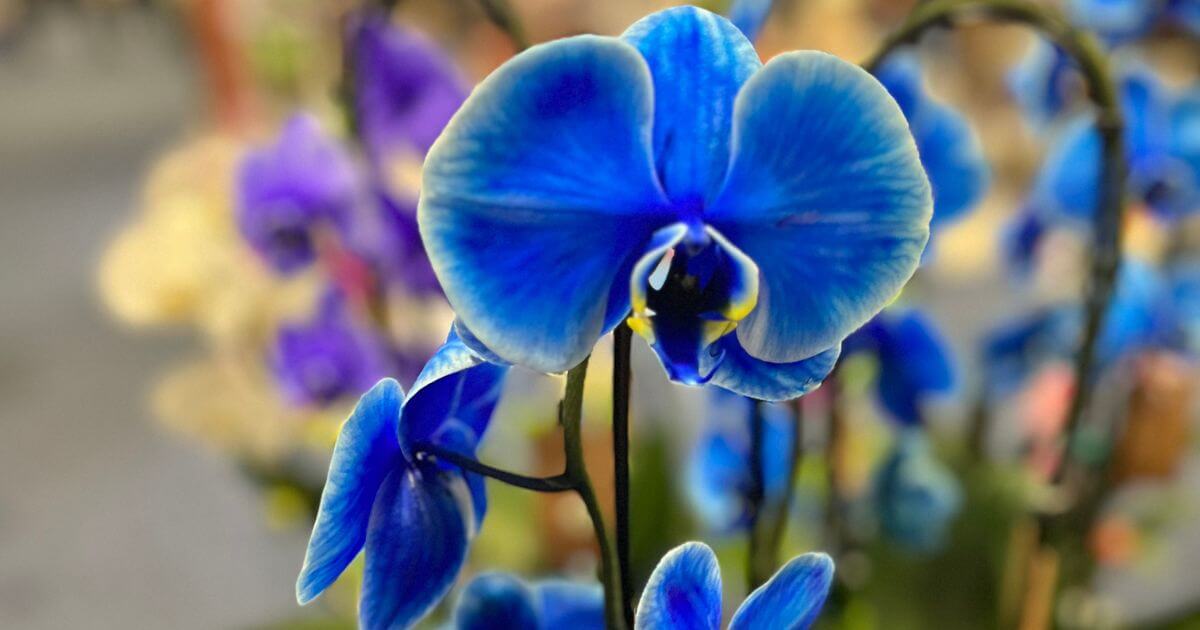Will Dyed Orchids Retain Their Color?
Perhaps you’ve seen an unusual orchid in the store and wondered, is that real? It may have been a brilliant red for Valentine’s Day or a green flower around St. Patrick’s Day or a deep, deep pink during Breast Cancer Awareness Month. The color is stunning and surprising, but you know these are not natural colors. They are dyed orchids.
Dyed or “inked” orchids are infused with unusual, often seasonal colors, making them great special occasion items similar to a bouquet or plant gift. A gardener cannot help but wonder, how did they get that color and will it last or will the orchid fade and die like a bouquet?
During a recent vacation in Florida, I had a chance to talk with representatives from Silver Vase Orchids, a plant wholesaler that counts Target and other retailers and garden centers among its customers. Its line of dyed orchids (called Mystique Orchids) come in eight colors from a deep indigo to nearly natural pink lemonade.

In most dyed orchids, the brilliant colors are achieved by injecting dye into the stem of the plant, which takes it up through its vascular system, leading to a colored bloom. Generally, growers start with an orchid that blooms in white because the white bloom will take up the ink most readily. Silver Vase uses an inking medium made from naturally derived elements and uses Phalaenopsis orchids for inking. Exactly what’s in the medium is a trade secret, but the process has been tested over many years and it’s environmentally conscious, they say.
While plants with white blooms are most commonly used for inking, the company uses a naturally purplish bloomer for its indigo orchids and a yellow orchid is used to produce the pink lemonade color.
What Happens When the Bloom Fades?
Orchid blooms last a long time—six to 10 weeks and sometimes more—so your dyed orchids will provide months of enjoyment. Orchids generally bloom once a year and the dyed orchids will rebloom—though not in the dyed color. When the blooms drop off, you can cut the stems back to a node or all the way back to the leaves. You can also leave the stem as is. If a stem starts to yellow or look sickly, cut it all the way back.
During the dormant period, continue to water the orchid weekly and fertilize it with a houseplant or orchid food once or twice a month. Place the plant in a bright room but not in direct sun. You’ll recognize the next bloom is emerging because its stem looks like a root with a pointed tip, heading upward rather than down. Increase fertilizing to once a week and wait for the blooms.
Because orchids have a strong filtration system, your orchid will revert to its natural color—probably white.
If you’re interested in orchids, Minnesota has an active orchid society. To see orchids in bloom, consider a trip to a local conservatory, such as the Como Conservatory or the University of Minnesota Conservatory. Both feature lovely tropical plants, including orchids.
Mary Lahr Schier is a longtime Minnesota garden writer.
To learn more, join a webinar or workshop: UPCOMING CLASSES


Thank you for this interesting article. I winter in Florida and just attended the Edison Plant show and purchased natural-colored orchids. I did wonder about the bright colored ones that I am seeing in the stores. My question is answered.
Enjoy your new orchids!
I have questioned whether or not dyed orchids are as hearty. My experience has been with natural orchids which bloom prolifically and for several months. When I was given a green orchid, blooms were dropping and those remaining were turning back to white. Also, no new growth while others have roots growing everywhere!
I’m new to orchids and have two which turned out to be dyed. One I’ve had a bit longer than the other and it’s completely lost its color and is now all white. The newest one is also losing its color. Is this normal? Is there anything I can do to maintain the color?
Who knew orchids were dyed?!